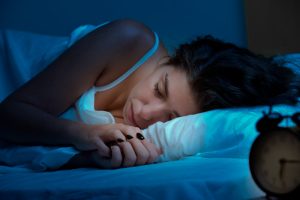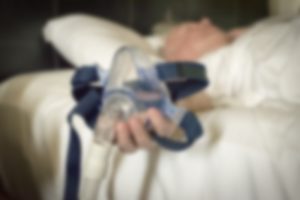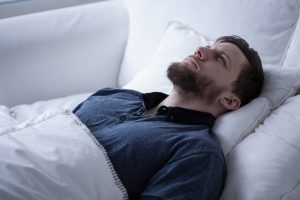What Your Dentist Can Tell You About Your Sleep
3 Jan 2017
Grinding and Obstructive Sleep Apnea
Most people aren’t aware that they grind their teeth, and even fewer realize what it can mean for their health. While a dentist performs their exam, they look for signs of grinding, or bruxism–like worn or broken teeth, excessive wear, a pie-crust tongue (more about this later), or bony growths along the jaws. They are also assessing your airway for risk factors of Obstructive Sleep Apnea (OSA), a serious medical condition.
What’s the connection? For years, grinding was treated as an oral problem arising from stress, missing or misaligned teeth, problems with the brain, or anxiety. We now know that in many cases, grinding is actually due to OSA. Why is this important? Well, the way grinding has traditionally been treated, with night guards, will not help people who grind because of OSA. In fact, it can make the problem worse! To fully understand the problem, let’s take a look at where it all happens–sleep.
What Happens When We Sleep?
We spend a third of our lives sleeping, but what are we really doing when we sleep? Up until the 1950’s, scientists believed that our brains just clicked off then magically clicked back on in the morning, like a computer. Because they had no way to measure brain activity, they had to rely on the power of observation. When you look at a sleeping person, what do you see? Not much– a slack-jawed, limp-limbed body that occasionally shifts position. No wonder they thought there wasn’t much going on inside the brain!
Thanks to EEG’s, scientists discovered that sleep is not a passive endeavor at all, but a highly complex and interactive process that your brain and body carry on together.
Let’s Break it Down
There are two cleverly named types of sleep, Rapid Eye Movement (REM) sleep and Non-Rapid Eye Movement (NREM) sleep. NREM sleep is further broken down into stages of increasing sleep depths of 1 – 3. When you go to sleep, you cycle through all the stages, starting with NREM-1 and ending with REM then cycling back up through them. Most people average 4 to 6 cycles a night. That’s right! You are a night-time dynamo! Now that you have the basic concept, let’s walk through a healthy sleep cycle to get a feel for what you are doing when you thought you were doing nothing!

The Sleep Cycle
You’re lying in bed, teeth brushed, of course, and you’re feeling sleepy after a long day of herding monkeys, or whatever it is that you do all day. You turn off the lights giving your brain its first signal to start transitioning to sleep. Light receptors in your eye send a signal to the part of your brain responsible for circadian rhythms which regulate sleep. Picture your brain as a car and your sleep cycle as a closed course. All you have to do is run the course four or five times to finish the race.
NREM Stage 1
Your eyes close, and as you doze off, you begin your journey through sleep. You are at the starting line. If someone were to call your name, you would wake easily and may not even know you were sleeping. You are drifting off, and this phase of sleep is the transition from wakefulness to sleep. This is the area of your sleep where you may startle or experience a sensation like falling. This stage is quick, lasting only between 1 and 7 minutes for most people!
NREM Stage 2
Now, you are officially asleep. Because you cycle down through the stages, then back up again, you spend about 50% of your time in Stage 2 sleep. Here, your breathing and heart rate slow down, your muscles relax, and your brain activity decreases from waking levels, but you can still be woken up fairly easily. Lots of memory work goes on here in Stage 2! Welcome to the first straight-a-way!
NREM Stage 3
It’s been about 30 minutes. You’ve fallen into deep sleep. Your brain waves switched from their waking patterns and your heart rate, blood pressure, and breathing have slowed significantly. Your muscles are relaxed. Your body is restoring at the cellular level. During the first NREM 3 stage of the night, hormones, vital to your body’s repair, are secreted. You will have a hard time being woken and will feel groggy or disoriented when woken from this deep sleep. You generally hang out here for an hour during your first cycle. Enjoy it now, you will spend less time here as the night progresses. Oh, and when you’re old, forget about it! Some people may not visit Stage 3 at all in old age. This is the trickiest part of the course. You are cruising now!
REM
After NREM Stage 3, you will drift back up to Stage 2 then the final stretch! About 90 minutes after you turned your lights off, you get to REM. Your brain activity returns to levels similar to wakefulness. This is where dreams are made! Your limb muscles are paralyzed, presumably to keep you from acting out your crazy dreams, and your brain gets to work on its memory banks and learning centers. Almost to the finish line! This part of the track is all about information storage. Woot! Your first REM stages of the night are relatively short, but they grow much longer in later cycles. In normal sleep, you will spend about 20% of your time here. VROOM!
Cycle Restarts
Now, you’ve completed a single cycle of sleep. You will continue to cycle until morning when you should wake rested and refreshed. Your sleep cycles can be graphed in a hypnogram. There, you can get a picture of what is referred to as your Sleep Architecture, so named because the hypnogram looks like the skyline of a city. Cool, huh?

What is OSA?
Back to grinding and your airway. There are more than 70 different sleep disorders. OSA is one of three disorders that fall into the category of Sleep Disordered Breathing. That simply means OSA doesn’t allow you to cycle through the sleep stages normally. Your sleep architecture changes and you don’t benefit from your sleep like you should, leading to breakdowns of body systems.
How does OSA Affect Sleep?
Let’s introduce OSA to your sleep cycle. Remember your car on the closed course? OSA is like a series of obstacles blocking the middle of your lane. Here’s how it works: aptly named, OSA, happens when your airway is obstructed and you stop breathing. When the muscles of the mouth, tongue, and throat relax, the airway can collapse or become blocked by other tissues.
Let’s say, you are laying on your back. You drift into sleep and happily make it to REM, almost to the end of your first lap. Your muscles relax, but your throat no longer has the tension to keep your airway open, so it collapses. You are now unable to breath–this is apnea–like your car zooming around the track and finding a brick wall on the road. Luckily, your brain supplies a detour in the form of your gnashing jaws.
Your body wants air. Your car makes a few attempts to push the wall down, and BAM! Jaws gnas and teeth grind– you take sudden detour off the track as you shoot out of REM back into a higher, lighter sleep level, or wake up completely, to take a breath. This will be the first of many detours of your night.
Now you have to find your way back on course. Your REM sleep was interrupted and you were unable to complete the first lap. With constant detours, you may never complete a full lap! People with OSA spend more time in REM and sometimes no time in some of the other stages of sleep. Each time there’s a blockage, your jaws gnash and you are sent off course again.
Now, you can see that it is during your body’s push to breath that the grinding occurs. Your brain sends out a signal, your jaws start moving to open the throat, and you take a breath. Remember that pie-crust tongue? In some people it is caused when the tongue thrusts against the teeth in an effort to breath. Imagine if you are wearing a nightguard–it could actually make breathing more difficult by crowding the tongue or, in some cases, repositioning the jaw backward, impeding the airway even more. Yikes! Studies have shown that if you treat the OSA, the grinding goes away!
How Does OSA Affect Your Health?
OSA has serious consequences for your health. If you don’t make the proper pit-stops during your sleep stages, you can’t keep your engine running! Your dentist can help! Dentists examine your airway and your teeth, both of which tend to show signs of OSA before symptoms appear in other parts of the body. Many serious health problems show up with OSA. Here are a few examples:
- Diabetes
- Heart disease
- Stroke
- high blood pressure
- Obesity
- Behavioral changes
- Breakdown of teeth
OSA can be successfully treated and treatment can save lives! Catching OSA early is your best bet for success!

What are the Risk Factors for OSA?
When thinking of risk factors for OSA think SWAP
- Snoring
- Weight
- Airway (anatomy of neck and throat)
- Position (Back sleeping)
Snoring is often an early indicator of OSA. While not all snoring is caused by OSA, it should always be evaluated. Snoring is not normal. Your dentist can make you a snore-guard, once OSA is ruled out. Obesity is the largest risk factor for OSA. It is also a result of it, making it a challenge. Large neck circumference (16” for women and 17” for men) poses higher risk, and certain anatomical factors like large tonsils, large tongue, small jaw, will play a role. Sleeping on your back is another risk factor–gravity is not your friend when it comes to your airway.
What are Symptoms of OSA?
Wondering if you have OSA? Here are some common symptoms
- Grinding your teeth
- Daytime sleepiness
- Irritability
- Fatigue
- Weight gain
- Sore throat
- Morning headaches
- Snoring
Take the Epworth Sleepiness Test for a quick indication of your risk of OSA.
How Do You Test For OSA?
Once you suspect you may have OSA, you will be referred to a sleep specialist for evaluation. Your sleep specialist will need you to complete a sleep study, where your sleep is monitored and recorded for a diagnosis. Don’t worry! Sleep studies are not hard and some can even be done at home! Your diagnosis will be made using a number of factors and your Apnea Hypopnea Index (AHI) will be determined. Your AHI describes how many times you stopped breathing (apnea) and how many times you had a drop in your blood levels of oxygen (hypopnea) per hour of sleep.
Scores under 5 are normal
- 5 to 14 – Mild OSA
- 15 – 29 – Moderate OSA
- 30+ – Severe OSA
How Do You Treat OSA?
OSA can be mild, moderate, or severe. Depending on your diagnosis, treatment may be one or more of the following:
Continuous Positive Airway Pressure (CPAP) Machine:
- Works by pushing air into the airway to keep it open
- Most common mode of treatment for moderate and severe OSA
Oral Appliance:
- Mandibular Advancement Device
- Works by gently positioning the jaw forward and opening the airway
- Best for mild to moderate OSA
- Best when patient cannot tolerate CPAP
- Tongue positioners
- Work by pulling the tongue forward
Surgery:
- Works by permanently unrestricting the airway
- Repositioning the jaw
- Reshaping or removing the soft tissue at back of throat
Your Dentist and Sleep
Your dentist is here to help you keep your health at its best! Sleep is a vital part of your overall health and your dentist can see signs and symptoms of sleep disorders in your mouth and help you make the best decisions for your health! Remember, grinding your teeth isn’t just about your teeth! Report any symptoms or concerns at your next visit!
Related Blog Articles